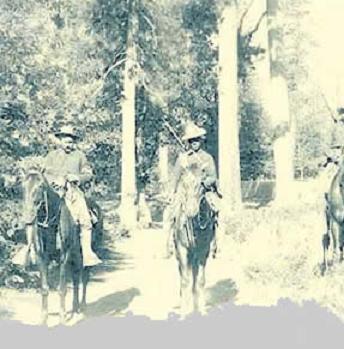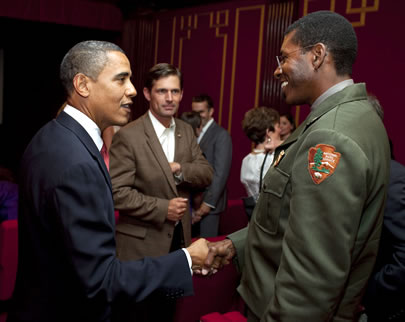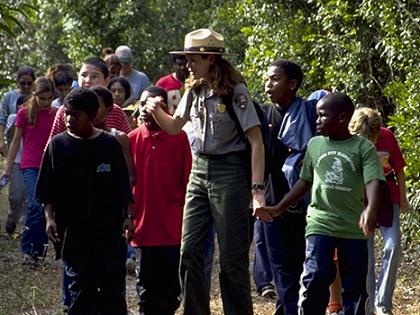
Parks work to attract minority visitors
Last summer, Yosemite National Park Ranger Shelton Johnson saw something he doesn’t see on a regular basis: an African American family admiring the natural beauty of one of America’s national parks.
It was a moment that Johnson wishes all families, especially minority families, could share together.
That family taking in the sights at Yellowstone National Park in Wyoming was the nation’s First Family, the Obamas.
Aside from the First Family’s visit, there is not much diversity among the visitors to national parks. While the National Park Service does not keep detailed records about the ethnicity of park visitors, recent studies commissioned by individual parks claim that roughly 90 percent of park visitors are white. And that number that has not changed much in the last decade.
 |
Buffalo Soldiers served as some of the first park rangers at Yosemite National Park in the early 20th century. The history of the Buffalo Soldiers at Yosemite is being celebrated today through Shelton Johnson’s novel “Gloryland” (Photos courtesy of National Park Service). |
There is no clear explanation as to why so few minorities visit national parks. Economic, geographic and cultural reasons have been suggested, but Shelton Johnson feels it’s a combination of many factors.
“We’re all suffering from ‘Nature Deficit Disorder,’” said Johnson. “We learn to recreate from our parents, so if our parents never went to parks, as is the case with most minorities, the kids won’t even think to go to national parks. So when they go to take a vacation, the thought of experiencing the wilderness is entirely foreign. Because they don’t know what to expect from a visit to a park, it creates an anxiety, and the purpose of a vacation is to rid oneself from all anxiety.”
Johnson isn’t the only one to notice the problem with the lack of minority visitors in the parks. In 2008, the National Parks Conservation Association convened the National Parks Second Century Commission. The purpose of the commission which was comprised of scientists, historians, business leaders, politicians, and former NPS employees, was to develop a twenty-first century vision for the NPS.
| The NPS is encouraging minority youths to pursue careers in the parks. Through training programs, job shadowing and internships, the NPS is hoping to increase diversity among park employees. Currently, 80 percent of full time park employees are white. |
One of the prime objectives laid out in the commissions’ final report was to encourage more diversity among park visitors and park employees. The commission encouraged the NPS to achieve this diversity by means of community outreach programs, NPS employment training programs, and promoting awareness of sites that celebrate the historical achievements of minority groups.
One organization reaching out to minority youths is WildLink in Northern California. The organization partners with local high schools and middle schools to turn young minority students into “Wilderness Ambassadors” who will in turn promote interest in the parks and wilderness activities within their friends and families.
WildLink takes students on five day wilderness expeditions, exposing them to parks often for the first time. The students take part in a wilderness-based curriculum where they learn about the importance of environmental issues, and how it impacts them. After the expedition, WildLink helps set up programs in the students’ communities in attempt to expand interest in the parks and wilderness among others in the community.
 |
Yosemite Park Ranger Shelton Johnson shakes hands with President Obama at the premiere of the PBS Documentary “The National Parks: America’s Best Idea.” Johnson is a leading voice in the NPS initiative to attract more minorities to the parks. |
WildLink also offers family weekends where the students from the expeditions can take their parents into the wilderness and serve as teachers. WildLink Community Coordinator Paul Martin, thinks that giving the students a chance to teach their parents about the parks is the way to change the lack of diversity in national parks today.
“This is the way we’re going to change things, by getting the whole family in,” said Martin. “By making the kids the liason between their family and the wilderness, we’re creating interest where there was previously none. It’s pretty amazing when you consider these kids had no exposure to the wilderness, and now their taking their parents here and saying ‘this is my park, my mountain and these are the issues its facing, and how it affects us.’”
WildLink also offers a program called “Bridge” where the organization partners with the NPS to offer internships and job shadowing opportunities for careers in the parks and environmental fields. Like the visitors to the parks, there is little diversity among park employees. 80 percent of full time parks employees are white.
Other organizations such as the Multicultural Environmental Leadership Development Initiative (MELDI) and the Student Conservation Association encourage minority youths to seek careers in the parks and environmental fields. By employing more minorities, parks are hoping they will be able to create more interest in minority communities.
In addition to promoting diversity among park employees, the NPS and other organizations have tried to raise awareness about historical points of interest in national parks that pertain specifically to minority groups. One of the most recent parks to celebrate African American achievement is Northern California’s Yosemite.
Shelton Johnson, who is Yosemite’s only full time African American employee, is the park’s expert on the history of the Buffalo Soldiers, the all black infantry unit, who served as some of the first park rangers at the turn of the 20th Century. Johnson has written a book on the history of the Buffalo Soldiers at Yosemite entitled “Gloryland,” which he hopes will raise African American interest in the park.
| By exposing minority youths to the wilderness and parks, the NPS is hoping to increase minority interest in the parks. Several schools in culturally diverse areas have partnered with the NPS to reach out to minority groups. |  |
Johnson was a featured ranger on the recent six-part PBS documentary “The National Parks: America’s Best Idea.” Despite reaching an audience of about 33.4 million people, the documentary failed to create the dialogue about the issue of minorities visiting national parks about which Johnson was hoping.
While the lack of publicity was upsetting, he is optimistic that trends are changing and through outreach programs, documentaries and books, Johnson believes minority interest in the parks is slowly rising.
“It’s not going to happen right away,” said Johnson. “The fix is if we can get that African American family here. It will take a pioneer, because it’s not the “black thing” to do now. But firsts are a powerful thing. And the first time you take in a sight like you do here, it’s enough to change you.”

Comments are Closed